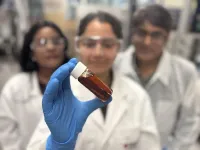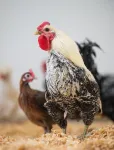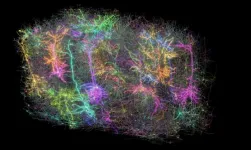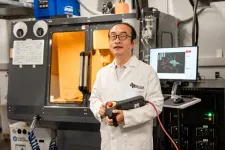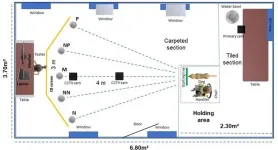(Press-News.org) Australian technology developed at RMIT University could enable more sustainable and cheaper production of bio-oils to replace petroleum-based products in electronic, construction and automotive applications.
The technology, known as PYROCOTM, uses high temperatures without oxygen to convert treated sewage (biosolids) into a carbon-rich product called biochar, which can act as a catalyst to produce phenol-rich bio-oil.
PYROCOTM has been developed by RMIT in collaboration with South East Water, Intelligent Water Networks and other water authorities over several years and is now being applied to several exciting circular economy applications.
The RMIT team's latest research in collaboration with the Indian Institute of Petroleum, published in Renewable Energy, highlights that biochar derived from biosolids can effectively replace the expensive catalysts currently used to extract oil from biomass such as Willow Peppermint, a plant native to Australia.
This discovery shows that biochar from biosolids, produced using advanced pyrolysis technology such as PYROCOTM, offers a sustainable way to reduce carbon dioxide emissions by replacing high-emission products.
The use of biochar made from biosolids as a catalyst could underpin a sustainable supply chain for bio-oils rich in phenol that are essential for making valuable chemicals such as resins, lubricants and additives used in various industries.
The researchers produced bio-oil with high levels of phenolics (69%) and hydrocarbons (14%) during their experiments, showing their biochar to be an effective catalyst.
Scaling up
RMIT’s Professor Kalpit Shah, Deputy Director (Research) of the ARC Training Centre for the Transformation of Australia’s Biosolids Resource, said PYROCOTM was close to commercial-ready scale.
RMIT and partners Aqua Metro, South East Water and its commercial arm Iota have secured $3 million from the Australian Government to build a commercial-scale demonstration plant (Mark-3) at one of the water recycling plants at South East Water next year.
“Our upcoming project aligns with the Global Waste Management Policy and Australia’s National Waste Policy Action Plan. Our goal is to prevent PFAS-contaminated biosolids from being disposed of in landfill by converting them into PFAS-free biochar, for its diverse applications,” Shah said.
“According to an International Biochar Initiative report, biochar will have a global market potential of $3.3 billion by next year, showcasing a truly circular solution.”
The project aligns with stricter PFAS regulations introduced in the recent PFAS National Environment Management Plan 3.0 (NEMP 3.0).
South East Water is contributing $3 million in funding and collaborating with other partners to drive this innovative $11 million project that supports a sustainable future.
Tried and tested technology
RMIT has filed patent applications to protect the technology that researchers have developed in collaboration with South East Water, Intelligent Water Networks and Greater Western Water.
RMIT has selected Iota as the commercialisation partner for PYROCO.
The latest trials of the technology (Mark-2) at the Melton Recycled Water Plant pave the way for large-scale deployment, following on from two earlier successful trials that included the removal of pathogens, PFAS and microplastics from biosolids.
“The Mark-2 unit recently processed biosolids from five different water utilities across Australia to create biochar. Three more biosolid feedstocks will be processed in the next few months.” Shah said.
South East Water Managing Director, Lara Olsen, said the latest PYROCO trials and upcoming demonstration project represented significant progress for the water sector in terms of environmental sustainability and innovation.
“We’re tackling a national challenge by harnessing cutting-edge technology with the potential to destroy 99.99% of PFAS in biosolids,” Olsen said.
“The PYROCO project reflects our vision of innovating with purpose to protect our environment for future generations.”
Aqua Metro Chief Executive Officer, Manish Pancholi, said the organisation was proud to be leading the way in PYROCO technology.
“Aqua Metro is excited and proud to have been awarded this Cooperative Research Centre Project (CRC-P) grant, leading the commercialisation of PYROCO technology along with our RMIT, South East Water, Iota and other partners.”
“We see a unique opportunity for this technology to provide significant decarbonisation, environmental and circular-economy benefits to the water industry and potentially other industries and are looking forward to proving the PYROCO technology at scale,” Pancholi said.
The latest RMIT study was conducted in collaboration with Dr Thallada Bhaskar's research group at the Council for Scientific and industrial Research – Indian Institute of Petroleum.
‘Role of carbo-catalyst on upgrading the pyrolysis vapors of spent Eucalyptus nicholii biomass: Towards sustainable phenolics production’ is published in Renewable Energy (DOI: 10.1016/j.renene.2025.122468).
MULTIMEDIA
Photos (with caption/credit information) available for download: https://spaces.hightail.com/space/bazxPDPrXr
END
Aussie tech helps make bio-oils for greener industrial applications
2025-04-09
ELSE PRESS RELEASES FROM THIS DATE:
Map of genetic regulation in chickens could help fight against bird flu
2025-04-09
An international team of researchers led by Professor Huaijun Zhou from the UC Davis Department of Animal Science has created the first-ever detailed map of how genes are regulated in chickens — a breakthrough that could help scientists breed birds that are more resistant to diseases like avian influenza.
The study, published April 8 in Nature Genetics, brings together a massive amount of genetic and epigenetic data of more than 100 chicken breeds from around the world. The team, which ...
Scientists map unprecedented detail of connections and visual perception in the mouse brain
2025-04-09
What: In a massive scientific effort funded by the National Institutes of Health (NIH), hundreds of researchers have helped to map the connections between hundreds of thousands of neurons in the mouse brain and then overlayed their firing patterns in response to visual stimuli. This breakthrough is a critical piece of foundational science to build toward understanding how our brains process visual information to reconstruct the images we see every day.
Information processing in the human brain occurs ...
Mapping mercury contamination in penguins of the Southern Ocean
2025-04-09
In 1962, when environmentalist and author Rachel Carson penned Silent Spring, alerting the world to the dangers of the pesticide DDT, it was the reproductive threat to birds – the bald eagle in particular – that spurred people to action.
Six decades later, Rutgers University–New Brunswick researchers are taking the measure of another global environmental pollutant by drawing parallels to the crisis Carson identified. This time, the pollutant is mercury, and the sentinels are penguins living in the farthest reaches of the Antarctic Peninsula.
“With mercury, there’s an analogy to DDT,” said John Reinfelder, a professor in the Department of Environmental Sciences ...
Engineer aims to make giant leap for welding materials on the moon
2025-04-09
Before humans can colonize the moon or Mars, scientists and engineers must first develop techniques for building permanent structures and pressurized habitats in harsh, thin-atmosphere and low-gravity environments.
Dr. Wei Li, an assistant professor of mechanical engineering in the Erik Jonsson School of Engineering and Computer Science at The University of Texas at Dallas, is developing a virtual lunar welding platform to troubleshoot assembling large structures in such conditions.
“As we try to return to the ...
Tracking firearm violence and impact on dental health
2025-04-09
Higher firearm violence in neighborhoods is linked to lower rates of people going to the dentist and higher rates of total tooth loss, known as edentulism, according to Rutgers researchers.
Their study, published in the American Journal of Preventive Medicine, used data from the Centers for Disease Control and Prevention for dental care utilization and complete loss of teeth and data from the American Violence Project for firearm violence incidents. The researchers examined 20,332 census tracts within the 100 largest cities in the United States from 2014 to ...
3D streaming gets leaner by seeing only what matters
2025-04-09
A new approach to streaming technology may significantly improve how users experience virtual reality and augmented reality environments, according to a study from NYU Tandon School of Engineering.
The research — presented in a paper at the 16th ACM Multimedia Systems Conference on April 1, 2025 — describes a method for directly predicting visible content in immersive 3D environments, potentially reducing bandwidth requirements by up to 7-fold while maintaining visual quality.
The technology is being applied in an ongoing NYU Tandon National Science Foundation-funded project to bring point cloud video to dance education, making ...
How does heavy drinking affect the brain?
2025-04-09
EMBARGOED FOR RELEASE UNTIL 4:00 P.M. ET, WEDNESDAY, APRIL 9, 2025
MINNEAPOLIS — Heavy drinkers who have eight or more alcoholic drinks per week have an increased risk of brain lesions called hyaline arteriolosclerosis, signs of brain injury that are associated with memory and thinking problems, according to a study published on April 9, 2025, online in Neurology®, the medical journal of the American Academy of Neurology. The study does not prove that heavy drinking causes brain injury; it only shows an association.
Hyaline arteriolosclerosis is a condition that ...
Father with Alzheimer’s? You may be more at risk of brain changes
2025-04-09
EMBARGOED FOR RELEASE UNTIL 4:00 P.M. ET, WEDNESDAY, APRIL 9, 2025
MINNEAPOLIS — While some studies have suggested that having a mother with Alzheimer’s disease may put you more at risk of developing the disease, a new study finds that having a father with the disease may be tied to a greater spread of the tau protein in the brain that is a sign of the disease, according to a study published on April 9, 2025, online in Neurology®, the medical journal of the American Academy of Neurology. The study does not prove that having a father with Alzheimer’s results in these brain changes; it only shows an association.
The study also showed ...
MSU research: Eating brown rice increases exposure to arsenic compared to white rice
2025-04-09
Why this matters:
Arsenic levels in brown rice were found to be higher for U.S. consumers than in white rice, despite people often looking to brown rice as a healthier alternative.
There is significant arsenic risk for U.S. children under 5 who consume brown rice, as arsenic is a toxic chemical element that can lead to health problems.
Arsenic levels in U.S.-grown rice were found to be considerably lower than rice grown outside the country, suggesting there is concern to U.S. consumers who eat rice grown outside the country.
EAST LANSING, Mich. – Whether you buy rice at the grocery store or order a side of it while ...
Do “optimistic” versus “pessimistic” medical detection dogs perform differently?
2025-04-09
A new, exploratory study has revealed statistical links between the performance of medical detection dogs and their scores on behavioral and affective tests, finding that more “optimistic” dogs tended to perform better overall on detection tasks, but “pessimistic” dogs had higher scent detection specificity. Sharyn Bistre Dabbah of the University of Bristol, U.K., and colleagues present these findings in the open-access journal PLOS One on April 9, 2025.
Animal researchers commonly use a method called judgment bias testing to help assess animals’ emotional states. For example, dogs may first be trained to associate a specific location in a room ...
